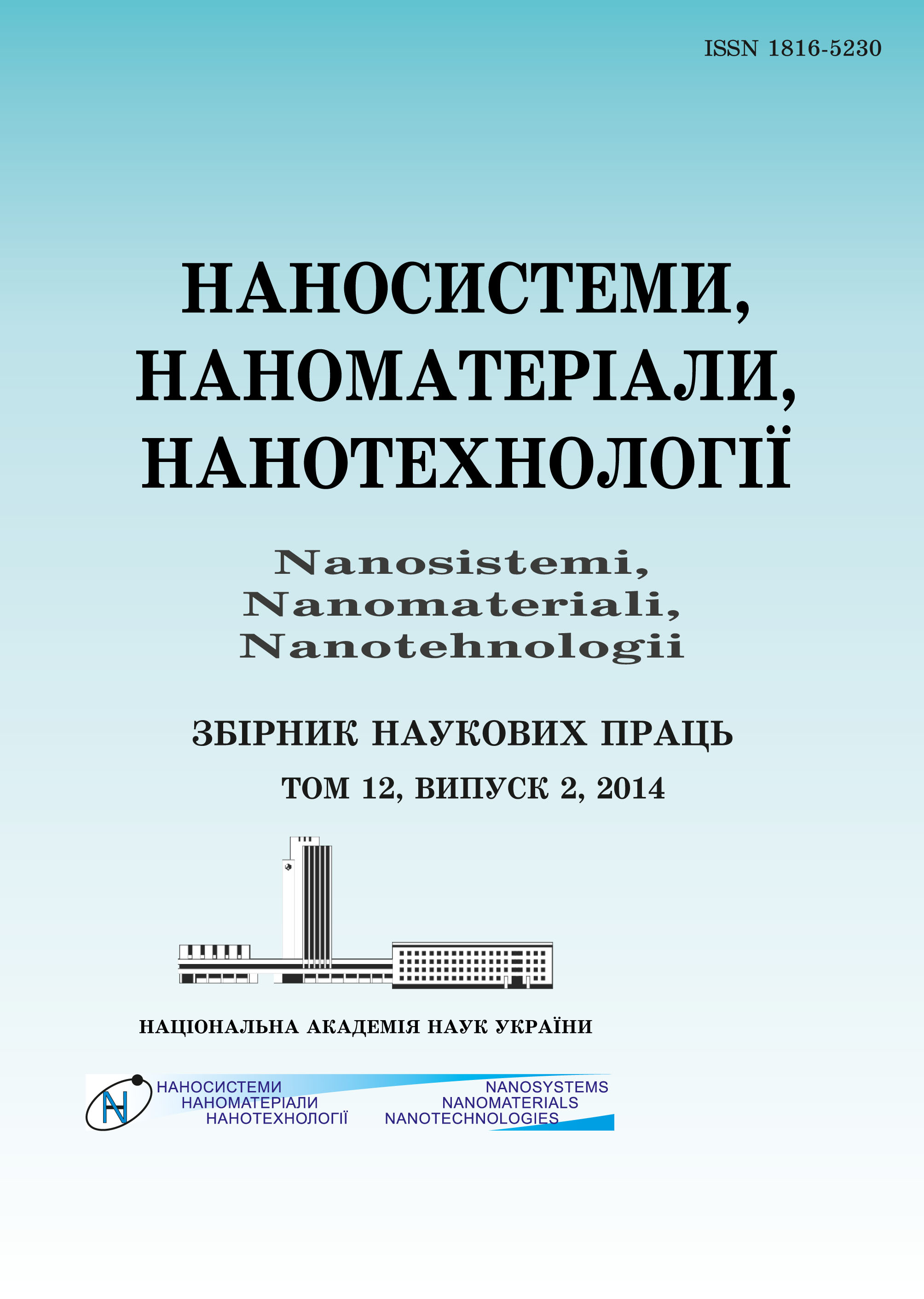|
|
|||||||||
 |
Year 2017, Volume 15, Issue 2 |
|
|||||||
|
|||||||||
Âûïóñêè/2017/òîì 15 /âûïóñê 2 |
B. B. Kolupayev, B. S. Kolupayev, V. V. Levchuk, Yu. R. Maksymtsev, V. O. Sidletsky
«Deviation Module of Compressibility of Metalnanodisperse Polymeric Systems»
235–250 (2017)
PACS numbers: 43.35.Mr, 62.23.Pq, 81.07.-b, 82.35.Lr, 82.35.Np, 83.60.-a, 83.80.Ab
In the megahertz range of frequencies, investigations of viscoelastic shear modules, volume deformation, and corresponding coefficients of dissipation of the ultrasonic-field energy, internal pressure and time of life of structural elements of PVC systems depending on the temperature are carried out. As revealed, the nanodisperse metal fillers (Cu, NiCr) obtained by the EVP method and/or chemical and electric dispersing work as effective modifiers of viscoelastic properties of PVC systems. Quantitative interrelation between the volume density of energy of a material and internal pressure is established. As shown, in case of volume deformation of an aggregate, in the field of ultrasonic frequencies, there is a deviation module of compressibility, whose value depends on the frequency of action of an ultrasonic field, relaxation time of structure elements and dynamic viscosity, and rigidity modulus of a material. As shown, the most essential changes of viscoelastic properties of the heterogeneous polymer systems (GPS) take place at introduction of more than 0.05 vol.% of filler, whose activity depends on a fabrication method, to a polymeric matrix. In the range 0.15 ? ? ? 0.5 vol.%, filler influences not only fluctuation structure of a matrix, but also determines the size of internal pressure of a material due to power interaction at the polymer–nanodisperse metal interphase boundary. In the explored areas of maintenance of a filler and action of the temperature field, the magnitude of the deviation module of the GPS compressibility in relation to the module of volume compression of a material changes nonlinearly depending on the type of ingredients, whose activity decreases in a series of NiCr, Cu (E/H), Cu (EVP). The revealed correlation ratios between the internal pressure and the elastic modulus of a material show that, when GPS is deformed by a dynamic mechanical field, it is necessary to consider an additional component to value of the bulk compression modulus in the form of the deviation module. Obtained results are specifying a possibility of use of such an aggregate as dampers of the acoustic lines of a time delay and sound insulators in the ultrasonic range of frequencies. Ways of the directed regulation of specifics of behaviour and the use of PVC systems at dynamic and thermal loadings are offered.
Key words: metalnanodisperse filler, deviation module, viscosity, ultrasound, compressibility.
https://doi.org/10.15407/nnn.15.02.0235
REFERENCES
1. Ya. P. Mamunya, Funct. Mater., 7, No. 4: 671 (2000).
2. V. V Turov, P. P. Gorbik, and V. M. Ogenko, Appl. Surfac. Sci., 166, Nos. 1-4: 492 (2000).
https://doi.org/10.1016/S0169-4332(00)00481-5
3. B. S. Kolupaev, Relaksatsionnyye i Termicheskie Svoistva Napolnennykh Polimerov [Relaxation and Thermal Properties of Filled Polymers] (L'viv: Vyshcha Shkola: 1980) (in Russian).
4. A. D. Pomogailo, A. S. Rozenberg, and I. E. Uflyand, Nanochastitsy Metallov v Polimerakh [Metal Nanoparticles in Polymers] (Moscow: Khimiya: 2000) (in Russian).
5. B. S. Kolupaev, M. A. Bordyuk, and Yu. S. Lipatov, Dop. NAN Ukrainy, No. 8: 112 (1995) (in Ukrainian).
6. B. B. Kolupaev, J. Eng. Phys. Thermophys., 85, No. 3: 684 (2012).
https://doi.org/10.1007/s10891-012-0702-1
7. T. G. Lyashuk and B. B. Kolupaev, Surf. Eng. Appl. Elect., 48, No. 5: 487 (2012).
https://doi.org/10.3103/S1068375512050079
8. S. Ya. Frenkel', I. M. Tsygel'nyi, and B. S. Kolupaev, Molekulyarnaya Kibernetika [Molecular Cybernetics] (L'viv: Svit: 1990) (in Russian).
9. B. B. Kolupaev, J. Eng. Phys. Thermophys., 80, No. 1: 188 (2007).
https://doi.org/10.1007/s10891-007-0026-8
10. R. A. Guyer and P. A. Johnson, Phys. Today., 52, No. 4: 30 (1999).
https://doi.org/10.1063/1.882648
11. G. M. Bartenev and S. Ya. Frenkel', Fizika Polimerov [Physics of Polymers] (Leningrad: Khimiya: 1990) (in Russian).
12. Ya. I. Frenkel', Kineticheskaya Teoriya Zhidkostey [Kinetic Theory of Liquids] (Leningrad: Nauka: 1975) (in Russian).
13. L. Yu. Grosberg and A. R. Khokhlov, O Nereshyonnykh Problemakh Statisticheskoi Fiziki Polimerov [About the Unsolved Problems of Statistical Physics of Polymers] (Moscow: Nauka: 1989) (in Russian).
14. I. I. Perepechko, Akusticheskie Metody Issledovaniya Polimerov [Acoustic Methods of Investigation of Polymers] (Moscow: Khimiya: 1973) (in Russian).
|
©2003—2021 NANOSISTEMI, NANOMATERIALI, NANOTEHNOLOGII G. V. Kurdyumov Institute for Metal Physics of the National Academy of Sciences of Ukraine.
E-mail: tatar@imp.kiev.ua Phones and address of the editorial office About the collection User agreement |